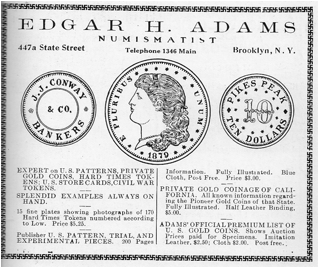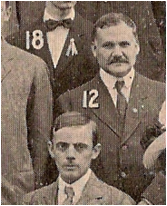
PREV ARTICLE
NEXT ARTICLE
FULL ISSUE
PREV FULL ISSUE
EDGAR HOLMES ADAMS (1868-1940)John Lupia submitted the following information from the online draft of his book of numismatic biographies for this week's installment of his series. Thanks! As always, this is an excerpt with the full article and bibliography available online. This week's subject is author Edgar H. Adams. -Editor
Due to his disability he was home-schooled by his aunt and purportedly by his father. Confined to a quasi sedentary life early on young Adams saw the first appearance of the new design of George T. Morgan for the Silver Dollar in 1878, those of John A. Kasson for the Stella $4 gold pieces in 1879, Charles E. Barber’s design of a nickel-five cent piece in 1883, the cessation of minting the nickel three-cent piece and $1 gold pieces in 1889, and the first appearance of three other Barber designs for the dime, quarter and half dollar in 1892. His later interest was highly focused on pattern and trial pieces coined at the U. S. Mint, undoubtedly inspired by his personal experiences with these changes in coinages during his adolescent and early adult years. In any event, to compensate for the loss of his lower extremities he took up swimming allowing him to exercise all of his limbs and body. In 1895 he married Sarah E. Kelly, affectionally called Sadie, a first generation Scotch-Irish–American from New York. They had no children. She encouraged his swimming and as a member of the Bath Beach Swimming Club won his first quarter-mile championship at Coney Island on July 31, 1902. He became so proficient a swimmer that as a member of the Human Fish Club and New York Athletic Club he won the Metropolitan Amateur Athletic Union championship for plunging for distances from the years 1902 to 1905 with his record of 66 feet 9 inches, in March of 1905. He swam in the 1904 Summer Olympics at St. Louis, Missouri, taking the silver medal in the plunge and 4th place in the 220 and 880-yard freestyle and relay races. Though handicapped, he enjoyed a very active and full life and moved his residency and business at least eleven times from 1900 until his death in 1940. Evidently, after the 1904 Summer Olympic games Adams intended to plunge into numismatics full-time as a professional career with all of the force and determination of an Olympian. He entered the field of numismatics as a champion and incessantly was a champion at his numismatic work. In 1905, he began writing a regular column for hobbies focusing on coin and stamp collecting for the Sunday edition of a New York newspaper, The Sun, as the editor. He was paid $12 per article and some weeks published at least two or more articles. Judging by the depth of his knowledge he must have been involved in numismatics for some years prior to his journalistic debut and had adequate credentials to get the job. Nevertheless, later that year he joined the ANA in December 1905 and is member no. 785. It is possible that the first piece published by Adams for The Numismatist, though unsigned, was in the May issue reporting the results of the Chapman Brothers sale of the Harlan Page Smith collection, which sold May 8-11, 1906, with the title, "Rare Gold Coins Bring Big Prices," the theme of Adams’ first book published in 1909. His application for ANA membership was vouched for by Geoffrey Charlton Adams and Howland Wood. No familial relationship has yet been established between the two Adams, if any exists. The next year he became an Associate Member of the ANS on November 19, 1906. Publishing articles through the publication organs of each numismatic organization Adams emerged as an expert in numismatic journalism and in various numismatic series. Adams was a regular attendant at the ANA Conventions beginning in 1907 until 1915. In 1908, he was appointed Chairman of the Ballot and Proxies and Resolutions Committee; and is No. 12 in the group photograph published in The Numismatist. He was also appointed to the Coin Design Committee of the ANA. He proposed at the 1908 ANA Convention that the dues be increased to $1.50, with $1.25 going to Zerbe as owner and publisher of The Numismatist and $0.25 going into the treasury of the ANA. Also, he proposed that the ANA become incorporated and a committee be appointed to weigh the pro’s and con’s; and was also voted into the Board of Governors of the ANA. In July 1909, he declined the nomination for ANA First Vice-President.

In January 1908 Adams was appointed by the president Archer M. Huntington to the ANS Standing Committee on United States Medals. In the September 1908 issue of Mehl’s Numismatic Monthly, Adams published an article, "The Value of Numismatic Societies". Certainly, Adams could appreciate the invaluable service numismatic societies afford those who wish to pursue dedicated research in this field being a member of the ANA, ANS, New York Numismatic Club, Chicago Numismatic Society, and British Numismatic Society. He was a charter member in 1908 of the New York Numismatic Club (NYNC), where he served as Treasurer from 1908 to 1911. In July 1909 he exhibited at the NYNC his rare 1882 Silver Dollar Pattern piece designed by George T. Morgan.
He is the author of an unpublished monograph, American Rare Coin Counterfeit Detector, begun in 1910 and fully described in the February 1910 issue of The Numismatist. As he was photographing coins for this book he ran a public notice in The Numismatist, "Colonial Counterfeits Wanted," May-June (1910) : 145, looking for certain specimens he was lacking. According to the 1910 U. S. Census report he was working as a numismatist in a store. Which coin shop he was affiliated with is not clear since he may have been independent and rented desk space in any store. His involvement with gold coinages caused him to be the voice at the 1910 ANA New York Convention to the U. S. Mint to revert back to the former frost proof finish on gold proof coinages. On February 10, 1911 he held his only coin auction and published the catalog and prices realized sheet of the duplicates of rare pattern pieces belonging to William H. Woodin at the auction rooms of Daniel R. Kennedy, New York. The catalog : Rare Pattern Coins, Comprising Many Pattern Duplicates of Mr. William Woodin, contained nine photographic plates though the original notice of the free catalog promised two or more. The catalogue was privately printed in Brooklyn, New York by the author in green paper and green card stock covers. Also, beginning in 1911 he published the initial installment of : Private Gold Coinages of California, 1849-1855 : Its History and Its Issues, originally intended as a series of articles to be published in the American Journal of Numismatics, Volumes 45-46 (1911-1912), in eight parts. In October 1911 it was issued in off prints as four issues in paper wrappers, sometimes bound variously by purchasers or kept in the paper covers as issued. An advertisement of these pamphlets ran in the October 1911 issue of The Numismatist on page 385. In January 1913, it was reprinted as a single volume with a 20-page and in February a second edition a 28-page introduction, sold in half morocco binding just prior to the distribution of the final quarterly issue of October-December 1912, when American Journal of Numismatics converted to a single annual issue. From March 1912 to July 1915 he served as the first salaried editor and publisher of he Numismatist, as an ANA owned publication at the rate of $720 per annum plus expenses. Beginning in May 1912, the masthead lists him as editor and business manager, rather than publisher. The correction of the ANA as publisher is clarified in the December 1912 issue of The Numismatist on page 469. He was succeeded as editor in August 1915 by Frank G. Duffield. Also, in 1913, his most acclaimed masterpiece and classic work was co-authored with William Hartman Woodin, the future Secretary of the Treasury under Franklin Roosevelt (from March 4 to December 31, 1933) : United States Pattern, Trial and Experimental Pieces. American Numismatic Series No. 1 (New York: American Numismatic Society, 1913). The book announcement was in a full-page advertisement in the March issue of The Numismatist on page 177. The Deluxe Edition in full Morocco was limited to fifty copies. The Regular edition was bound in dark blue cloth. Two other 1913 publications are : first, New York City and State Store Cards. (New York Numismatic Club, 1913). Second, Hard Times Tokens Illustrated in fifteen photographic plates of 170 varieties with the corresponding number given in Low’s Hard Times Tokens. In 1920 he published with Wayte Raymond a book on the history of American merchant’s store cards and checks entitled : United States Store Cards: A List of Merchants’ Advertising, Checks, Restaurant Checks and Kindred Pieces Issued from 1789 up to Recent Years (New York : E. H. Adams & W. Raymond, 1920). Also, he published a 24-page Fixed Price List of "United States Store Cards" Numbered According to List Prepared by Edgar H. Adams in 1920. In 1929 he published the Catalogue of the Collection of Julius Guttag, illustrated with halftones : Catalogue of the collection of Julius Guttag, comprising the coinage of Mexico, Central America, South America and the West Indies. Compiled by Edgar H. Adams. (New York, 1929).[21] In the 1930’s he produced two manuscripts on colonial New England coins. One covered Massachusetts silver of 1652 and the early state copper coinages of the half cent and cent. The other the Willow, Oak and Pine Tree coinages. Both manuscripts appear to have served as the working model for Sydney Philip Noe’s later works. Both manuscripts are in the ANS archives. Sometime around 1935 he became bedridden and died on May 5, 1940 at his home, Bayville, Long Island, New York.
To read the complete article, see:

Wayne Homren, Editor The Numismatic Bibliomania Society is a non-profit organization promoting numismatic literature. See our web site at coinbooks.org. To submit items for publication in The E-Sylum, write to the Editor at this address: whomren@gmail.com To subscribe go to: https://my.binhost.com/lists/listinfo/esylum All Rights Reserved. NBS Home Page Contact the NBS webmaster 
|

